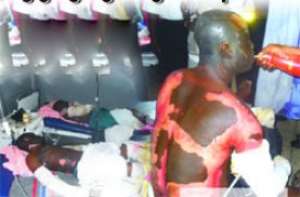
All the five victims of the Ashaiman gas explosion who were admitted to the Korle Bu Teaching Hospital are reported dead.
This brings to six the number of people who have died from the explosion which resulted in the injury of 18 people.
The Director of the Reconstructive Plastic Surgery and Burns Centre of the Korle Bu Teaching Hospital, Dr Opoku Ware Ampomah, told the Daily Graphic that aside three people who had died earlier at Korle-Bu, two more died on Wednesday.
Although he declined to give the names of the dead, information gathered by the Daily Graphic indicated that Pascal Amuzu, Prince Agyare and Richard Dzineku, were the latest victims of the gas victims to succumb to death.
Those who died earlier were Abdullai Manamu and Baba Issaka Yakubu.
Dr Ampomah said even though the centre did all it could to save those who died, the extent of their injury, coupled with the absence of intensive care facilities and skin substitutes, made it very difficult to save their lives.
“When you have almost your entire skin burnt you are exposed to a lot of infections and the absence of substitute skin makes it more difficult to treat the patients,” Dr Ampomah said.
He said because more than half of the skins of the victims were burnt, it was difficult to obtain skin for grafting purposes.
In other parts of the world, cadaver skin is removed from donors shortly after their death, processed, stored and distributed by skin and tissue banks.
The cadaver skin has been the preferred alternative for a patient with the most severe burns until a graft of the patient's own skin can be applied.
Skin graft is a patch of skin that is removed by surgery from one area of the body and transplanted, or attached to another area.
Dr Ampomah said in other part of the world there were skin banks or skin substitutes which played a major role in treating burns victims.
He said even though the cadaver skin might be rejected by the body later, it helped in speeding the treatment of burns victims.
According to experts, donated skin could help prevent infection, reduce pain and maintain body temperature. Patients with severe burns do not initially reject cadaver skin, because their immune systems are suppressed.
Meanwhile, another victim of the accident has been referred from the Ridge Hospital to the Korle Bu Teaching Hospital.
According to Dr Ampomah, the patient who arrived at the hospital yesterday with 61 per cent of his skin burnt was in a critical condition.
Although the cause of the Ashaiman explosion is yet to be established, fire officials had indicated that the explosion could be the result of the use of inferior cylinders.
Even though the use of second-hand cylinders is frowned upon by Legislative Instrument (LI 1963, 2001), such cylinders could be spotted for sale at locations in the Central Business District of Accra, the Kwame Nkrumah Circle and Kasoa.
In December, last year, 3,000 second-hand gas cylinders initially registered at the Tema Port as transit goods to Burkina Faso were impounded by the Special Operations Unit (SOU) of the Customs, Excise and Preventive Service (CEPS) .
The goods were impounded when a surveillance team of the unit reported that the trucks had diverted their course and were unloading the goods at Kasoa-Amanfrom.
Experts say it is dangerous to use a cylinder for more than 10 years because by that duration, it may have lost its durability and ability to withstand pressures but the lack of knowledge of safety measures means a number of households could be exposed to danger.




 We’ll no longer tolerate your empty, unwarranted attacks – TUC blasts Prof Adei
We’ll no longer tolerate your empty, unwarranted attacks – TUC blasts Prof Adei
 Bawumia donates GHc200,000 to support Madina fire victims
Bawumia donates GHc200,000 to support Madina fire victims
 IMF to disburse US$360million third tranche to Ghana without creditors MoU
IMF to disburse US$360million third tranche to Ghana without creditors MoU
 Truck owner share insights into train collision incident
Truck owner share insights into train collision incident
 Paramount chief of Bassare Traditional Area passes on
Paramount chief of Bassare Traditional Area passes on
 Two teachers in court over alleged illegal possession of BECE papers
Two teachers in court over alleged illegal possession of BECE papers
 Sunyani: Victim allegedly shot by traditional warriors appeals for justice
Sunyani: Victim allegedly shot by traditional warriors appeals for justice
 Mahama vows to scrap teacher licensure exams, review Free SHS policy
Mahama vows to scrap teacher licensure exams, review Free SHS policy
 Government will replace burnt Madina shops with a new three-story, 120-store fac...
Government will replace burnt Madina shops with a new three-story, 120-store fac...
